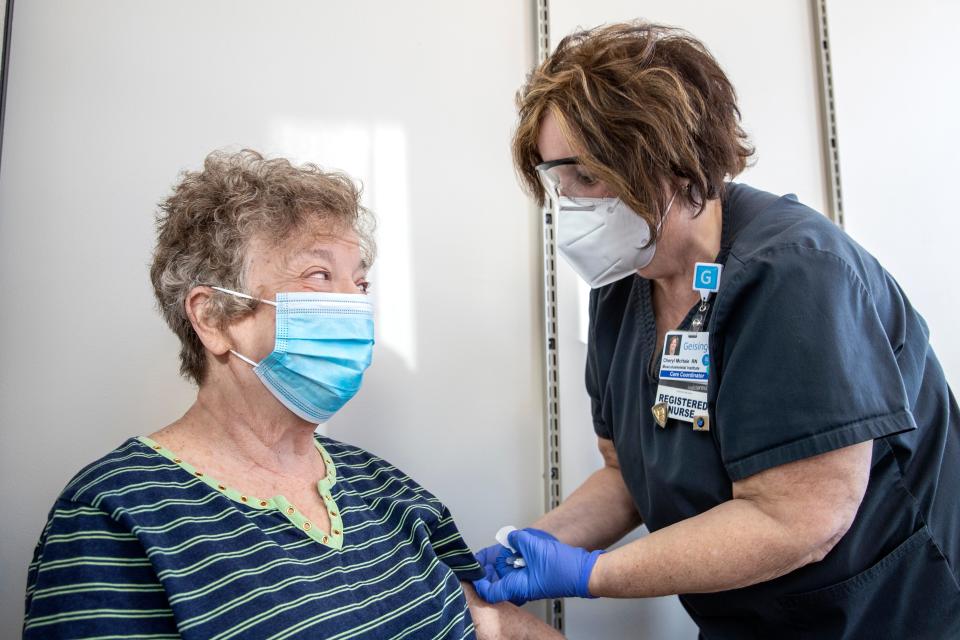People hospitalized with COVID-19 now have one overwhelming thing in common. They're not vaccinated.
In Minnesota, the HealthPartners system has seen a “precipitous decline” in COVID-19 hospitalizations, says Dr. Mark Sannes, an infectious disease physician and senior medical director for the system, which operates nine hospitals and more than 55 clinics. But now, nearly every admitted patient he does see is unvaccinated.
“Less than 1% of our hospitalized COVID patients are vaccinated," he said.
In Ohio, at University Hospitals Cleveland Medical Center, only 2% of the COVID-19 patients admitted in the last month were vaccinated, said Dr. Robert Salata, the hospital's physician-in-chief.
And at Sanford Health, which runs 44 medical centers and more than 200 clinics across the Dakotas, Minnesota and Iowa, less than 5% of the 1,456 patients admitted with COVID-19 so far this year were fully vaccinated, said spokesperson Angela Dejene.
Falling rates of COVID-19 across the United States mask a harsh reality – the overwhelming majority of those getting sick and being hospitalized today are unvaccinated, while vaccinated patients are becoming rare.
Hospitals in states with the lowest vaccination rates tend to have more COVID-19 patients in intensive care units, according to hospital data collected in the past week by the Department of Health and Human Services and vaccination rates published by the Centers for Disease Control and Prevention.
Wyoming, Missouri, Arkansas and Idaho currently have the highest percentage of COVID-19 patients on average in their ICUs; those states all have vaccinated less than 40% of their population.
Medical centers say there's also an obvious change in the age of their sickest patients, as older people are much more likely to be vaccinated than younger.
"We're all seeing the same thing – when someone does get sick and comes to the hospital, they're much more likely to be young and unvaccinated," said Dr. Robert Wachter, professor and chair of the Department of Medicine at the University of California, San Francisco.
Cathy Bennett, president and CEO of the New Jersey Hospital Association, said the picture is the same in her state.
"As COVID vaccinations rolled out across New Jersey, there’s been a major shift in the ages of patients admitted to the hospital," said Bennett. "Unlike last spring, when those 65 and older accounted for the majority of hospitalizations, we’re now seeing more young people hospitalized with COVID."
In Ohio, Salata said the shift should be reassuring, showing the vaccines work.
"It sends a very strong message to the hesitancy people out there because the data speaks for itself," he said.
'It's not all about you'
Doctors say there are multiple reasons people aren't yet vaccinated. There are the hesitant, who still have questions and sometimes fall prey to misinformation, and the opposed, who often harbor anti-government or anti-science sentiments.
"We've had a little success when we've spoken to them on a one-to-one basis. We can give them the information that they need to make their decision," said Dr. Gerald Maloney, chief medical officer for hospital services at Geisinger health network, which runs nine hospitals in Pennsylvania.
Some still can't easily access vaccine, either because it's not available nearby or because they can't get time off work.
And while the U.S. government paid for all vaccines and vaccinations so no one should be charged, others remain fearful they will be on the financial hook for a shot, Maloney said.

Last week, Health and Human Services secretary Secretary Xavier Becerra clarified in a letter that providers may not bill patients for COVID-19 vaccines.
There's still a lot of work to be done to create the trust necessary for these groups to embrace vaccination, Maloney said.
"The people who say, 'It's my body, my choice?' Well, it's not all about you," he said. "It's also about the people that you're around."
At this point, every vaccination is a win, one more person who can't pass the virus along. That's especially true in families where children can't be vaccinated and are still at risk.
At Akron Children’s Hospital in Ohio, “we have not seen any kiddos who have been admitted to the hospital who have been vaccinated,” said Dr. Michael Bigham, a pediatric intensivist in the critical care unit.
Among children 11 and younger, who can’t yet get the vaccine, having vaccinated family members is keeping them out of the hospital, and protecting them against MIS-C, the multisystem inflammatory syndrome that can be a rare but dangerous aftereffect of a COVID-19 infection in children.
“Most of the kids we’re seeing in the hospital with COVID or MIS-C had COVID in their household, maybe a parent or a grandparent, and most of those individuals had not been vaccinated,” he said.
The message from health care workers is unanimous: They just aren't seeing many vaccinated people get sick.
In New Jersey, the percentage of COVID-19 hospitalizations among those ages 18 to 29 has increased 58% since the beginning of the year. By comparison, the percentage of COVID-19 hospitalizations among the 65 and older age group – with a statewide vaccination rate of more than 80% – declined by 31.2%.
The numbers are no coincidence, Bennett said.
"Vaccination," she said, "works in preventing severe COVID illness."
This article originally appeared on USA TODAY: Majority of COVID-19 hospital patients in US now unvaccinated, younger

